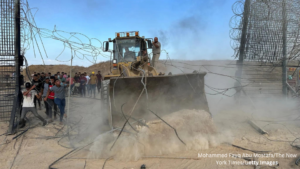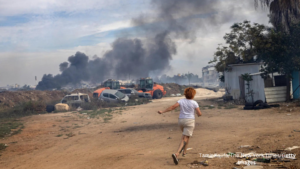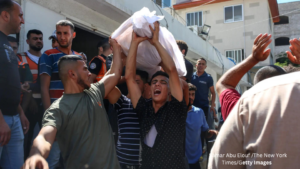Regarding Hamas strongholds, Israeli Prime Minister Benjamin Netanyahu has given a harsh declaration, promising to turn them “into rubble.” The continuous hostilities and tensions in the Gaza Strip between Israel and Hamas are reflected in this statement. Since it views Hamas as a terrorist group, the Israeli government is taking strong action against it. This new occurrence underscores the unstable state of affairs in the area and the likelihood of further confrontations.
According to Israeli and Palestinian sources, there have been close to 450 deaths in the Israeli-Palestinian war. Benjamin Netanyahu, the prime minister of Israel, has said that this conflict will be difficult and take a long period. In an unexpected early-morning attack on southern Israel, Palestinian militants from Gaza broke into 22 Israeli towns and army bases. Their actions included firing thousands of missiles towards distant towns, including Jerusalem, while kidnapping Israeli soldiers and civilians.

Early in the evening, fighting was still going on in at least five locations in southern Israel, and several Israelis had been kidnapped and transported to Gaza. At least 250 Israeli deaths and over 1,400 injuries were reported. At least 234 Palestinian casualties are known to have occurred as a result of Israel’s huge counterattacks against Gazan cities, which included both airstrikes and gunfights. This attack is unique in that it is large-scale and intricate, with militants entering Israel by air, sea, and land. As a result, Israeli and Arab forces engaged in fierce combat on Israeli territory, something that hasn’t happened in decades.

As the fight intensifies, both sides are faced with huge hurdles and a potentially combustible environment.
Unverified video footage that Hamas released purportedly showed some Palestinian gunmen breaking into Israel using an improvised hang glider. There were reports from border communities in Israel that gunmen were searching for homes door to door for residents. Unverified film from further sources revealed Palestinian fighters moving bodies and detained Israeli citizens, possibly as a negotiating chip for Palestinian detainees.
Photos from the southern Israeli city of Sderot showed corpses lying around the streets. A nighttime dance celebration in the desert was also targeted by the extremists, which caused a rush of young Israelis to evacuate for safety.
Benjamin Netanyahu, the prime minister of Israel, proclaimed that his country was at war and promised to win. He declared that hundreds of thousands of Israeli military reservists would be called up.
Hamas’s military wing commander, Muhammad Deif, stated in a taped statement that the group launched the operation to signal that Israel’s acts without repercussions were finished. His reasons included the occupation of the West Bank by Israel, recent police raids on Jerusalem’s Aqsa Mosque, and the imprisonment of thousands of Palestinian militants in Israeli prisons.
Both sides are suffering losses and there have been notable increases in violence, thus the situation is still unstable and hazardous. As the bloodshed in the region escalates, Israel is concerned about Iran’s possible involvement in the operation. In addition to Hamas, Tehran backs other militant Palestinian organizations like Islamic Jihad and gives Lebanese militant group Hezbollah weapons and intelligence. Arabs living in Israel and the West Bank have been advised by Hamas leaders to take advantage of the momentum created by the current attack and launch their own strikes against Israelis. Three Palestinians were reportedly killed in skirmishes with Israeli security forces on Saturday in the West Bank, according to Palestinian officials.

An increase in UN forces has been announced near Israel’s southern Lebanon border, an area heavily influenced by Hezbollah. This action follows a border confrontation on Saturday that highlighted the rising tensions in the area between Israeli troops and Hezbollah. The date of the attack on Israel is especially noteworthy because it took place 50 years to the day after the Yom Kippur War of 1973, which resulted in major Israeli losses and prompted contemplation about the country’s future. It also happened during a time when domestic tensions were at an all-time high.
Israelis have come together somewhat as a result of this attack; opponents of the government who had resigned from reserve duty over the administration’s proposal for judicial reform are now serving again in response to the situation. Furthermore, the leader of the opposition, Yair Lapid, said that he would be open to joining a government of national unity, which could delay additional judicial reforms and alter the political landscape. The attack also comes at the same time as Israel is working to seal a historic peace deal with Saudi Arabia, which had indicated that it would recognize Israel. The incident may or may not have an influence on these attempts at normalization, despite the Saudi authorities expressing alarm and calling for an end to hostilities. Due to the ease with which Palestinian fighters were able to enter Israel, concerns have been expressed regarding the accuracy of Israeli intelligence and the direction of Israeli military operations, which had been primarily focused on quelling insurgencies in the West Bank. Although Israel and Hamas combat frequently, this attack’s scope and intensity have never before been seen.

Israelis and foreign observers were taken aback by this attack since it was anticipated that the Gaza front would remain mostly quiet following reports that mediators had persuaded Hamas to put an end to previous border protests and rioting. The instability of the area has been exacerbated by the prolonged humanitarian situation in Gaza, which is characterized by high unemployment and restricted access to clean water. With Israel embroiled in a multifront conflict and mounting international concerns over the escalation of bloodshed, the situation is still unstable. Up to 18,000 laborers from Gaza could enter Israel every day in recent months, boosting the region’s economy and creating a comparatively peaceful environment. A physical assault was difficult because of the strong land border between Gaza and Israel, which made Hamas’s arsenal of rockets its main weapon.
On Saturday morning, however, Palestinian terrorists seemed to easily get past the border barriers, breaking through defenses and infiltrating many Israeli communities, army bases, and Sderot city. Ofir Libstein, the head of the Israeli municipal council, was subsequently shot and killed by militants. Fearful inhabitants of Israeli border towns recounted shooters entering their homes and forcing them to hide in the bomb shelters, which are standard fixtures in Israeli dwellings. Israel’s response began with ground operations in the militant-invaded towns and then spread to airstrikes throughout the Gaza Strip. At first, Gazan citizens celebrated the strikes on Israel and hailed the returning terrorists as heroes. However, when Israel’s response grew more intense, their joy gave way to fear.

Gaza City, the main metropolitan region in the Gaza Strip, saw its streets empty as many took refuge in schools and others formed lines to restock on supplies at stores. Living close to the Israeli border, Gazans took cover in the enclave’s safer parts, fearing an Israeli ground attack. The Israeli government responded to the situation by announcing that Gaza, which gets two thirds of its electricity from Israel, would no longer be receiving electricity.

Analysts voiced concerns that the battle in Gaza would lead to further bloodshed in the West Bank, where there has already been a spike in violence that has left many people dead on both sides. While the majority of Western countries denounced the fight, Hezbollah and Iran, among Israel’s enemies, applauded it, seeing it as an indication of Israeli weakness. Nasser Kanani, the spokesman for Iran’s Ministry of Foreign Affairs, said that the latest operation signaled the start of a new phase of military struggle against the occupiers in the seized regions.
Follow us on social media: Instagram, Threads & Twitter @nya360_ YouTube & Facebook @nya360.





